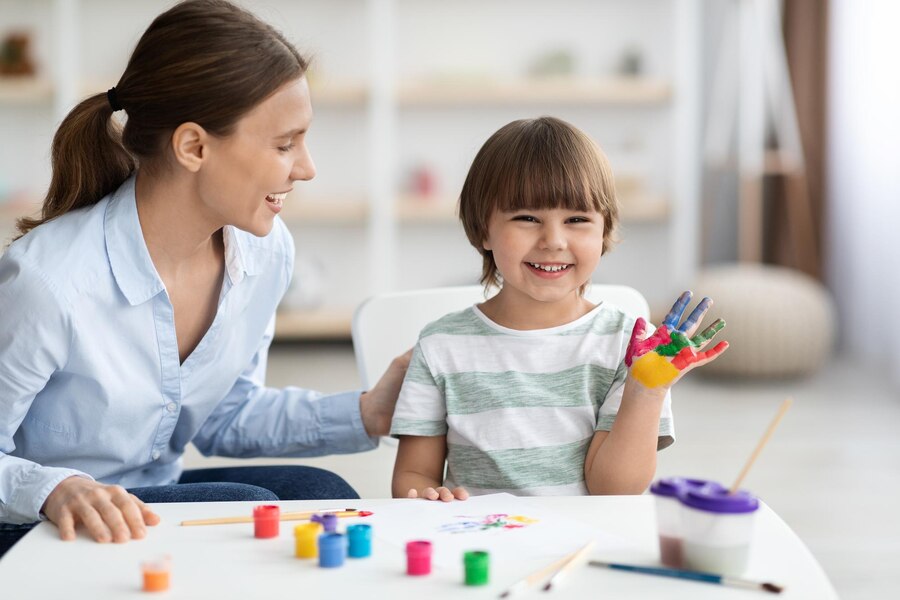ABA (Applied Behavior Analysis) therapy is an approach making a significant difference for non-verbal children by enhancing their communication skills. Imagine having a world of thoughts but no words to express them; for many non-verbal kids, ABA therapy is the key that unlocks their ability to communicate effectively. With this therapy, children can develop a way to convey their needs and ideas, bringing ease and understanding into their lives and those around them.
For families with non-verbal children, breakthroughs in communication are incredibly rewarding. Even small steps toward self-expression can lead to more joyous interactions and fewer frustrations. ABA therapy offers methods tailored to each child’s needs, helping them find their voice in a world that can often be overwhelming.
Understanding ABA Therapy
At its core, ABA therapy focuses on understanding and improving specific behaviors. It uses positive reinforcement to encourage desired actions, creating a supportive environment where children learn effectively. ABA therapy isn’t just about one-size-fits-all solutions; it’s about uniquely addressing each child’s needs to help them communicate better.
In practice, ABA therapy involves observing a child’s behavior and working with them to change patterns that might be holding them back from expressing themselves. It is deeply practical, breaking down tasks into small, manageable steps and rewarding successes along the way. For non-verbal children, this might mean starting with simple actions like pointing or gesturing, then gradually moving to more complex forms of communication like using signs or pictures.
Communication skills developed through ABA therapy enable children to express their needs, feelings, and desires, reducing the stress of misunderstandings. By focusing on individual strengths and areas for growth, ABA therapy helps children build the confidence they need to communicate effectively. As these kids gain these capabilities, they open new avenues for interaction, fostering relationships and increasing independence.
ABA therapy is a powerful tool that aids children in finding their voices, opening doors to a world where they can fully participate. It is an approach that embraces each child’s uniqueness, nurturing their ability to connect and express themselves in ways that enrich their lives and the lives of those around them.
Techniques Used in ABA Therapy for Non-Verbal Children
ABA therapy relies on a variety of techniques to help non-verbal children develop communication skills. Two widely used methods are the Picture Exchange Communication System (PECS) and sign language. PECS enables children to use pictures to communicate. Kids learn to select and exchange images to express needs, asking for things or making choices. This approach gives children a visual way to connect with others, helping them practice the basics of communication in a straightforward manner.
Sign language can be another useful tool, especially for children who thrive with physical movement and gestures. Simple signs allow kids to convey basic needs and emotions. Over time, as their confidence builds, children might move on to more complex expressions or even combine signs with spoken words.
In therapy sessions, these techniques are applied in a setting that encourages patience and repetition. A therapist might work with a child to help them identify a picture of a snack they want to eat. Through consistent practice and positive reinforcement, children start associating the picture or sign with what they want, eventually beginning to request items or express feelings without frustration.
Success Stories and Progress Indicators
ABA therapy’s success comes from its ability to break down communication challenges into achievable goals. This step-by-step approach makes progress visible and measurable. Some common indicators of progress include increased willingness to use pictures or signs, greater confidence when expressing needs, and a decrease in communication-related frustrations.
Success can also be seen in enhanced social interactions and responses. For instance, a child might begin to greet a familiar face with a smile or nod, showing an understanding of social cues. As these small victories accumulate, they signify a child’s growing ability to interact and build relationships with others.
How to Get Started with ABA Therapy
Beginning ABA therapy for a non-verbal child might seem overwhelming at first, but following some clear steps can simplify the process. First, consult with a pediatrician or child psychologist to discuss any concerns about communication. They can often provide referrals to qualified behavioral therapists.
– Schedule an evaluation with a therapist specializing in ABA. This assessment helps tailor the therapy plan to the child’s specific needs.
– Engage with therapists who have experience working in Silver Spring, MD. Local expertise ensures that the therapy aligns well with available resources and community support.
– Regularly communicate with the therapist to be an active partner in your child’s progress.
Creating a Supportive Environment at Home
Home can serve as a supportive backdrop for a child’s communication journey. To encourage growth, parents can integrate simple strategies throughout daily life:
– Create a designated space for practicing communication techniques learned during therapy sessions.
– Consistency is key, so make sure family members use similar methods to encourage communication.
– Celebrate small victories to motivate children and reinforce positive behavior.
Collaboration between therapists and families strengthens these efforts. By sharing insights and adjusting strategies, both parties ensure children receive consistent encouragement and guidance. This partnership lays the groundwork for a nurturing, communication-friendly environment.
Building a Brighter Future for Non-Verbal Children
Seeing children unlock their communication potential is incredibly rewarding. The long-term benefits of ABA therapy extend far beyond improving day-to-day interactions. As children develop these skills, they gain independence, confidence, and an enhanced ability to connect with others. Each step forward is a building block for a brighter, more empowered future. With continued support and dedication, non-verbal children can make significant strides toward expressing themselves and fully engaging with the world around them.
ABA therapy opens up new communication possibilities for children. If you’re exploring options for enhancing your child’s abilities, consider working with behavioral therapists for autism. At Behavioral & Educational Solutions P.C., you’ll find a team dedicated to supporting your family every step of the way.





